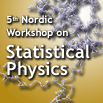Speaker
Mogens Hogh Jensen
(The Niels Bohr Institute, University of Copenhagen)
Description
In healthy blood vessels with a laminar blood flow, the
endothelial cell division rate is low, only sufficient to
replace apoptotic cells. The division rate significantly
increases during embryonic development and under halted or
turbulent flow. We study the long-range dynamics induced by
cell division in an endothelial monolayer under non-flow
conditions, mimicking the conditions during vessel formation
or around blood clots [1]. Cell divisions induce long-range,
well-ordered vortex patterns extending several cell
diameters away from the division site, in spite of the
system's low Reynolds number. We model these observations by
a hydrodynamic continuum model simulating division as a
local pressure increase in a non-nematic, meso-scale
turbulent state [1]. In order to describe the injected
energy by cell motion in the tissue we assume a negative
local viscosity stabilized by a higher order term. We find a
vorticity pattern very similar to the experimental
observations with a similar order and periodicity of the
patterns.
[1] N.S. Rossen, J.M. Tarp, J. Mathiesen, M.H. Jensen and
L.B. Oddershede, Nature Physics, under review (2014)

